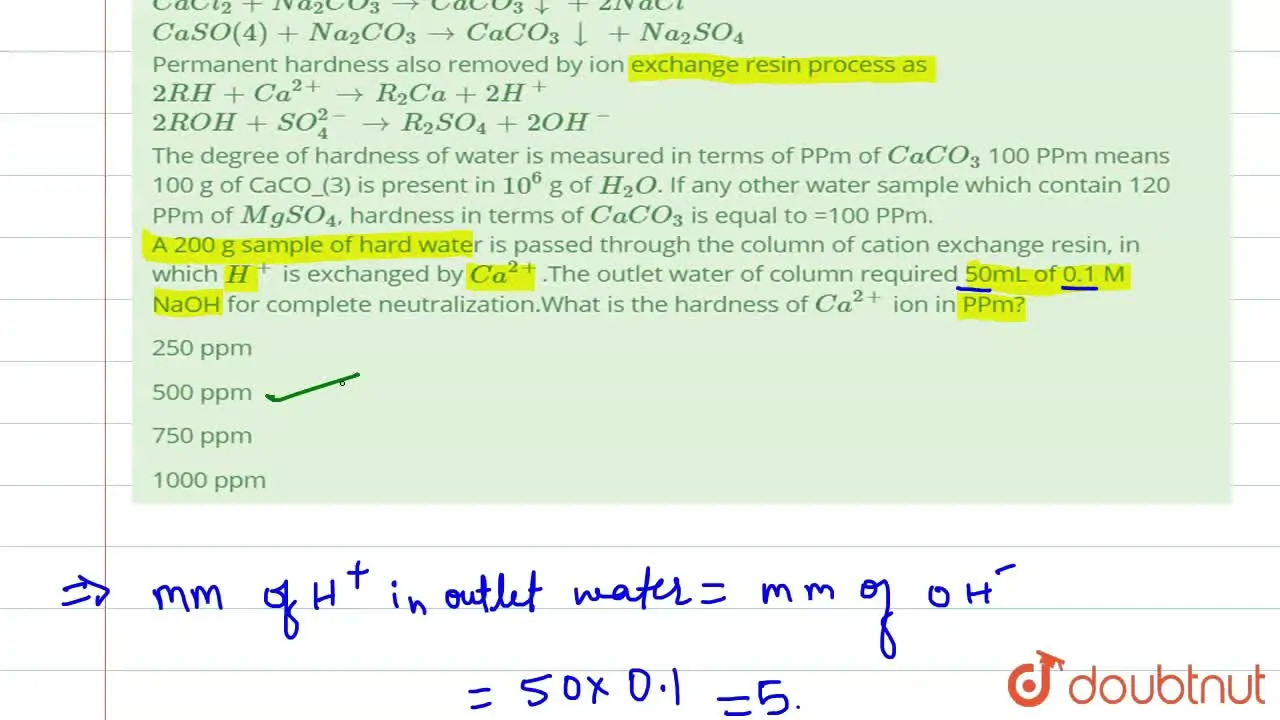A water is said to be soft water if it produces sufficient foam with the soap and waterthat does not produce foam with soap is known as hard water. Hardness has been classified into two types (i)Temporary hardness (ii) Permanent hardness.
Temporary hardness is due to presence of calcium and magnesium bicarbonate. It is simply removed by boiling as
Ca(HCO3)2Δ−−→CaCO3⏐⏐↓+CO2↑⏐⏐+H2O
Mg(HCO3)2Δ−−→MgCO3⏐⏐↓+CO2↑⏐⏐+H2O
temporary hardness can also be removed by addition of slaked lime, Ca(OH)2
Ca(HCO3)2+Ca(OH)2→2CaCO3⏐↓+2H2O
permanent hardsness is due to presencce of sulphates and chlorides of Ca,Mg,etc. It is removed by washing soda as
CaCl2+Na2CO3→CaCO3↓+2NaCl
CaSO(4)+Na2CO3→CaCO3⏐↓+Na2SO4
Permanent hardness also removed by ion exchange resin process as
2RH+Ca2+→R2Ca+2H+
2ROH+SO2−4→R2SO4+2OH−
The degree of hardness of water is measured in terms of PPm of CaCO3 100 PPm means 100 g of CaCO_(3) is present in 106 g of H2O. If any other water sample which contain 120 PPm of MgSO4, hardness in terms of CaCO3 is equal to =100 PPm.
A 200 g sample of hard water is passed through the column of cation exchange resin, in which H+ is exchanged by Ca2+.The outlet water of column required 50mL of 0.1 M NaOH for complete neutralization.What is the hardness of Ca2+ ion in PPm?
250 ppm
500 ppm
750 ppm
1000 ppm
The correct Answer is:B
Step by step video & image solution for A water is said to be soft water if it produces sufficient foam with the soap and waterthat does not produce foam with soap is known as hard water. Hardness has been classified into two types (i)Temporary hardness (ii) Permanent hardness. Temporary hardness is due to presence of calcium and magnesium bicarbonate. It is simply removed by boiling as Ca(HCO_(3))_(2)overset(Delta)rarr CaCO_(3)darr+CO_(2)uarr+H_(2)O Mg(HCO_(3))_(2)overset(Delta)rarr MgCO_(3)darr+CO_(2)uarr+H_(2)O temporary hardness can also be removed by addition of slaked lime, Ca(OH)_(2) Ca(HCO_(3))_(2)+Ca(OH)_(2)to2CaCO_(3)darr+2H_(2)O permanent hardsness is due to presencce of sulphates and chlorides of Ca,Mg,etc. It is removed by washing soda as CaCl_(2)+Na_(2)CO_(3)toCaCO_(3)darr+2NaCl CaSO(4)+Na_(2)CO_(3)to CaCO_(3)darr+Na_(2)SO_(4) Permanent hardness also removed by ion exchange resin process as 2RH+Ca^(2+)toR_(2)Ca+2H^(+) 2ROH+SO_(4)^(2-)toR_(2)SO_(4)+2OH^(-) The degree of hardness of water is measured in terms of PPm of CaCO_(3) 100 PPm means 100 g of CaCO_(3) is present in 10^(6) g of H_(2)O. If any other water sample which contain 120 PPm of MgSO_(4), hardness in terms of CaCO_(3) is equal to =100 PPm. A 200 g sample of hard water is passed through the column of cation exchange resin, in which H^(+) is exchanged by Ca^(2+).The outlet water of column required 50mL of 0.1 M NaOH for complete neutralization.What is the hardness of Ca^(2+) ion in PPm? by Chemistry experts to help you in doubts & scoring excellent marks in Class 11 exams.
Related Playlists
- BOOK - NARENDRA AWASTHI ENGLISHCHAPTER - STOICHIOMETRYEXERCISE - Passage-44videos
STOICHIOMETRY
- BOOK - NARENDRA AWASTHI ENGLISHCHAPTER - STOICHIOMETRYEXERCISE - Passage-53videos
STOICHIOMETRY
- BOOK - NARENDRA AWASTHI ENGLISHCHAPTER - STOICHIOMETRYEXERCISE - passage-24videos
STOICHIOMETRY
- BOOK - NARENDRA AWASTHI ENGLISHCHAPTER - SOLID STATEEXERCISE - Subjective Problems13videos
SOLID STATE
- BOOK - NARENDRA AWASTHI ENGLISHCHAPTER - THERMODYNAMICSEXERCISE - Level 389videos
THERMODYNAMICS
Similar Questions
A water is said to be soft water if it produces sufficient foam with the soap and water that does not produce foam with soap is known as hard water. Hardness has been classified into two types (i)Temporary hardness (ii) Permanent hardness.
Temporary hardness is due to presence of calcium and magnesium bicarbonate. It is simply removed by boiling as
Ca(HCO3)2Δ−−→CaCO3⏐⏐↓+CO2↑⏐⏐+H2O
Mg(HCO3)2Δ−−→MgCO3⏐⏐↓+CO2↑⏐⏐+H2O
temporary hardness can also be removed by addition of slaked lime, Ca(OH)2
Ca(HCO3)2+Ca(OH)2→2CaCO3⏐↓+2H2O
permanent hardsness is due to presencce of sulphates and chlorides of Ca,Mg,etc. It is removed by washing soda as
CaCl2+Na2CO3→CaCO3↓+2NaCl
CaSO(4)+Na2CO3→CaCO3⏐↓+Na2SO4
Permanent hardness also removed by ion exchange resin process as
2RH+Ca2+→R2Ca+2H+
2ROH+SO2−4→R2SO4+2OH−
The degree of hardness of water is measured in terms of PPm of CaCO3 100 PPm means 100 g of CaCO3 is present in 106 g of H2O. If any other water sample which contain 120 PPm of MgSO4, hardness in terms of CaCO3 is equal to =100 PPm.
What is the mass of Ca(OH)2 required for 10 litre of water remove temporary hardness of 100 PPm due to Ca(HCO3)2 ?View SolutionA water is said to be soft water if it produces sufficient foam with the soap and water that does not produce foam with soap is known as hard water. Hardness has been classified into two types (i)Temporary hardness (ii) Permanent hardness.
Temporary hardness is due to presence of calcium and magnesium bicarbonate. It is simply removed by boiling as
Ca(HCO3)2Δ−−→CaCO3⏐⏐↓+CO2↑⏐⏐+H2O
Mg(HCO3)2Δ−−→MgCO3⏐⏐↓+CO2↑⏐⏐+H2O
temporary hardness can also be removed by addition of slaked lime, Ca(OH)2
Ca(HCO3)2+Ca(OH)2→2CaCO3⏐↓+2H2O
permanent hardsness is due to presencce of sulphates and chlorides of Ca,Mg,etc. It is removed by washing soda as
CaCl2+Na2CO3→CaCO3↓+2NaCl
CaSO(4)+Na2CO3→CaCO3⏐↓+Na2SO4
Permanent hardness also removed by ion exchange resin process as
2RH+Ca2+→R2Ca+2H+
2ROH+SO2−4→R2SO4+2OH−
The degree of hardness of water is measured in terms of PPm of CaCO3 100 PPm means 100 g of CaCO3 is present in 106 g of H2O. If any other water sample which contain 120 PPm of MgSO4, hardness in terms of CaCO3 is equal to =100 PPm.
One litre of a sample of hard water (d=1 g/mL) cotains 136 mg of CaSO4 and 190 mg of MgCl2. What is the total hardness of water in terms of CaCO3 ?View SolutionThe temporary hardness of water is due to the presence of
View SolutionPermanent hardness in water due to presence of :
View SolutionPermanent hardness of water is due to the presence of
View SolutionSoft and hard water
View SolutionThe temporary hardness of water is due to :
View SolutionPermanent hardness of water is due to the presence of salts of Ca and Mg in the form of
View SolutionTemporary hardness is cauesd due to the presence of-
View SolutionWhy do soaps not work in hard water ?
View Solution


